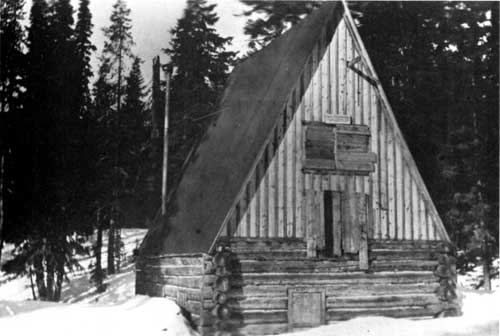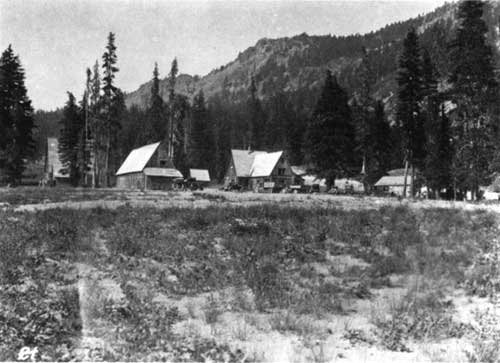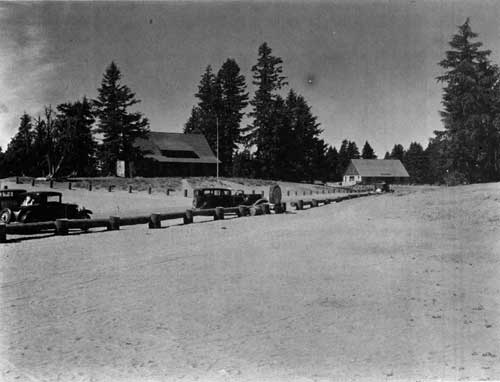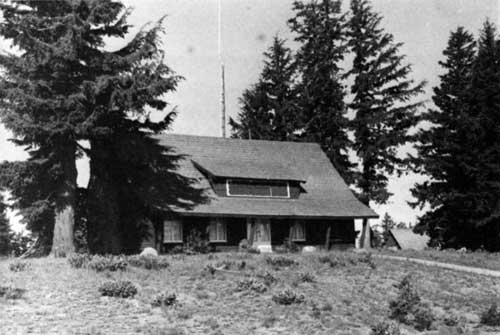|
Crater Lake Historic Resource Study |

|
X. Construction of
Government Buildings and Landscaping in Crater Lake National
Park (continued)
D. Headquarters Moved to Government Camp
In the spring of 1923 it was decided to gradually move the administrative headquarters to Government Camp, about a mile below the rim road (via the old road) and now the site of the present administrative center at the upper end of Munson Valley. Annie Spring would then serve only as an entrance station. Early in the season it had become apparent that visitors preferred accommodations with a view of the lake, so the Crater Lake Company, which ran both the lodge and the Anna Spring Camp, moved its tent-houses from the camp to the rim. A temporary shortage of water there would be remedied by installation of two more 20,000-gallon storage tanks. Also in 1923 a combination mess hall and bunkhouse, measuring twenty-two by forty feet and costing $1,500 with plumbing and hot water, was erected at Lost Creek for the convenience of early and late tourists arid two new toilets were built at the rim auto camp, plus a large septic tank. Two toilets were built at the Annie Spring auto camp and a large barn that could easily be converted into a warehouse. A seventy-foot log boat landing was built at Wizard Island, and a new bear-proof meat house and large Latrine at Government Camp. [17]

Illustration 30. U.S. Army Corps of Engineers camp, rim road, at present
headquarters site. Mess hall building. Owned by NPS, built by War
Department, 1914. Kitchen and mess hall on first floor, sleeping
quarters on second and third floors. Photo ca. 1917. Courtesy Klamath
County Museum.

Illustration 31. Government Camp (new park headquarters), pre-1930s.
Courtesy Crater Lake National Park.
E. Community House (Bldg. #116) Erected and Government Headquarters Enlarged
During the 1924 season a community house was built on a site at the rim near Crater Lake Lodge. Boasting a large rustic fireplace, it was designed to house audiences attending nightly lectures and entertainments given throughout the tourist season:
A Victrola was provided for the community house by the Medford, Oregon, "Craters," a booster organization dedicated to the advertising and development of Crater Lake National Park. Colonel Thompson's [C. G. Thomson] now famous "Kentucky Rangers" quartet added much to the pleasure of the informal gatherings which took place each evening. . . . It should be known that the appropriation which built the community house was originally intended by the government to cover the erection of a modern home for the park superintendent. The diverting of this appropriation to provide a community house is typical of Colonel Thompson s whole-hearted and unselfish interest in the development of the park. [18]
The building was cheaply constructed and of a style inharmonious to surrounding buildings. It also soon proved inadequate in size. The structure was ultimately used as headquarters for the park naturalist and as a museum in the daytime; at night the ranger service conducted a program for tourists that included lectures, music, and dancing. [19]
Also that year the log cabin (former army engineer bunkhouse) used as the office of the superintendent and as official headquarters at Government Camp was enlarged because of growing demands on registration and recording facilities. All buildings in this camp group were of log cabin construction with sharply peaked roofs and were able to withstand heavy snowfalls and extreme winter winds. Also mentioned as being located in this area was "Chef Van Camp's Cook House." [20]

Illustration 32. Community house and cafeteria, Rim Village. Courtesy
Crater Lake National Park. No date, but before cafeteria addition of
1956.

Illustration 33. Rim Center (former community house), 1981. Photo by
David Arbogast, NPS, DSC.
| <<< Previous | <<< Contents >>> | Next >>> |
crla/hrs/hrs10b.htm
Last Updated: 14-Feb-2002